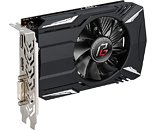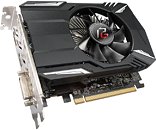Tuesday, November 12th 2019

ASRock Launches the Phantom Gaming Radeon 550 2G Graphics Card
No, that's not a typo. AsRock has actually launched an AMD Radeon 550 graphics card this late into the game. There is some sense behind the business decision, though; AMD's Radeon 550 is the company's entry-line offering, which aims only to improve upon the performance of integrated graphics solutions, and no more. In that sense, the Radeon 550 certainly delivers, though it does so in an underwhelming way for any tech enthusiasts. The Radeon 550 2G features 2 GB of GDDR5 memory clocked at 1,750 MHz (7,000 MHz effective) across a 64-bit bus, which feeds a die powered by 512 Stream Processors.
There are three operating modes on offer: Silent, for HTPC environments, which clocks the graphics card at 1,183 MHz boost clock and 7,000 MHz memory clocks. Default mode runs the card at AMD's defaults (1,183 MHz boost, 7,000 MHz memory). The OC mode overclocks the graphics card's boost clock to 1,230 MHz and the memory to 7,038 MHz. I/O stands at 1x dual-link DVI-D connector, 1x HDMI 2.0b port and 1x DisplayPort 1.4. A 50 W TDP should make it easy to cool in cramped spaces, and the graphics card doesn't require any power pins. No pricing was available at time of writing.
There are three operating modes on offer: Silent, for HTPC environments, which clocks the graphics card at 1,183 MHz boost clock and 7,000 MHz memory clocks. Default mode runs the card at AMD's defaults (1,183 MHz boost, 7,000 MHz memory). The OC mode overclocks the graphics card's boost clock to 1,230 MHz and the memory to 7,038 MHz. I/O stands at 1x dual-link DVI-D connector, 1x HDMI 2.0b port and 1x DisplayPort 1.4. A 50 W TDP should make it easy to cool in cramped spaces, and the graphics card doesn't require any power pins. No pricing was available at time of writing.


25 Comments on ASRock Launches the Phantom Gaming Radeon 550 2G Graphics Card
For chip with such low TDP, they could have used almost any cooler they had available or could put together using bits lying around. So they did.
AsRock is not selling many graphics cards and savings like this make their (fairly young) GPU endeavor worth the risk.
There's a real shortage of single-slot cards with more than two modern outputs (HDMI or DP) and with a 50W TDP such a thing should be very easy and affordable to produce.
Almost every single ATX board on the market with 3 or more PCIe x16 slots puts the last slot at the very bottom position, meaning that it cannot (usually) be used for dual-slot cooler. What's the point if there are no single-slot cards to even put in it?
I know Quadro and RadeonPro cards come in single-slot variety but I make no exaggeration when I say that they are 5-10x the price of the equivalent Geforce or Radeon.
What market really needs is some sort of basic and very cheap gpu (20-30$ range) that could handle 4k displays, modern codecs like vp9 and h265 and some 3D capabilities, so it makes it a real gpu (128-192SPs would be plenty enough). Now that would make a lot of sense (think of all the cheap ryzen 1200/1600 or xeon 2011 builds, that aren't built for gaming).
Of course a GT 730 (GT 1030) is cheaper - with multiple passive cooling xor single-slot models available for around $70.
But not everyone accepts an Nvidia logo in their PC and this is the kind of customer most RX 550 cards are trying to appeal to.
As for gaming: there are countries where a mainstream gaming PC has to cost less than $500, so RX 550 is a viable option.
Again: +$50 makes 1050Ti / 1650 possible, but some clients will prefer an AMD card anyway.
The next card above RX 550/560 is RX 570 and it's both expensive and more demanding (PSU, case cooling).
What is not stated is what video decoding it has, and if AMD is finally to develop their drivers to support different OSes than Windows 10 and VM software accordingly if they want to offer better support for other tasks than gaming and computing. There isn't an official driver for regular AMD gpus in Windows Server 2019 after a year.